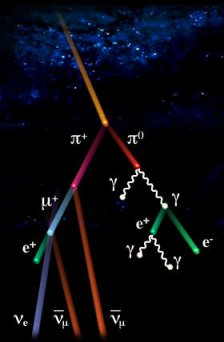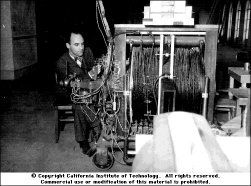


Drawing of a cosmic ray shower
Anderson close to his cloud chamber
A small cosmic-ray shower of positive and negative electrons
From 1928 to 1995
1930: nature's
helping hand
From 1930, the hunt for the
mysterious antiparticles began...
Earlier in the century, Victor Hess (Nobel Prizewinner in 1936) had discovered
a natural source of high energy particles: cosmic rays. Cosmic
rays are very high energy particles that come from outer space and as
they hit the Earth's atmosphere they produce huge showers of lower energy
particles that have proved very useful to physicists.
In 1932 Carl Anderson, a young professor at the California Institute of Technology, was studying showers of cosmic particles in a cloud chamber and saw a track left by "something positively charged, and with the same mass as an electron". After nearly one year of effort and observation, he decided the tracks were actually antielectrons, each produced alongside an electron from the impact of cosmic rays in the cloud chamber. He called the antielectron a "positron", for its positive charge. Confirmed soon after by Occhialini and Blackett, the discovery gave Anderson the Nobel Prize in 1936 and proved the existence of antiparticles as predicted by Dirac.
For many years to come, cosmic rays remained the only source of high energy particles. A steady stream of discoveries was made but for the next sought-after antiparticle, the antiproton (antipartner of the proton and much heavier than the positron), physicists had to wait another 22 years...


